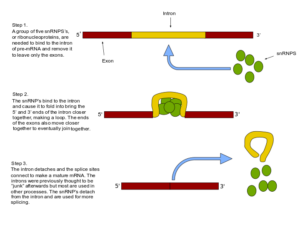Protein synthesis is an elaborate process, starting from DNA being coded to mRNA which is converted to an amino acid chain. These chains are joined to form polypeptide which is further aggregated to produce molecules.
Protein synthesized structures include traditional protein molecules that are components of muscles. But they also include other molecules like hormones and enzymes.
The main steps involved in protein synthesis structure include:
Protein Synthesis Structure:
Protein synthesis in prokaryotes consists of 3 steps- transcription, translation and post-translational processing. In eukaryotes, the subject is a bit more complex and consists of one extra step in between transcription and translation called post-transcriptional processing.
Here we will discuss the above-mentioned steps in detail:
Transcription:
Transcription is the process of producing mRNA or hnRNA (in the case of eukaryotes) by converting the template strand of DNA into its corresponding RNA molecule. This is done by complimenting the Nitrogen bases on the template DNA and adding the complementary ribosomal nucleotides side by side.

Image: Wikipedia
Initiation:
Refers to the beginning of the transcriptional process triggered by the arrival of the RNA polymerase enzyme and attaching itself to the promoter region of the DNA. This, in turn, sends a signal to the DNA double helix to unwind with the help of an enzyme called helicase. The RNA pol reads the Nitrogen bases and starts producing a complementary RNA nucleotide

Image: Wikipedia
Elongation:
After each complementary ribonucleotide is formed it attaches to the previous one by replacing a single oxygen atom from the phosphate moiety of the nucleotide
Termination:
Termination of the transcription occurs when RNA polymerase encounters something called a Stop Codon usually represented by one of the three of UAA, UAG or UGA. With this, the RNA polymerase and the mRNA or hnRNA in prokaryotes and eukaryotes detaches from the DNA strand and the DNA double strands wind up again in the original double-helix formation.
Post-transcriptional modification:
Eukaryotes have non-coding regions in their DNA which is also reflected in the RNA produced. So the hetero-nuclear RNA molecule undergoes some modification to produce functional mRNA. These modifications include- capping splicing and tailing of the hnRNA.
Capping:
Capping is simply the attachment of a molecule of 7-methylguanosine (m7G) to the 5′ end of the hnRNA molecule. The terminally positioned phosphate at the 5′ end must be eliminated during the capping process, which is accomplished by a phosphatase enzyme. Consequenctly the enzyme guanosyl transferase then catalyses the formation of the diphosphate 5′ end in plave of the cleaved phosphate group at the 5’ end.
Splicing:
Splicing is the process of removing introns (RNA segments that do not code for proteins) from pre-mRNA and linking the remaining exons to form a single, continuous molecule. Exons are mRNA sequences that are “translated” into proteins. Exons are the portions of the mRNA molecule that can actually code for specific amino acids. Although most RNA splicing happens after the pre-mRNA is fully generated and end-capped, transcripts with a significant number of exons can be spliced co-transcriptionally.

Image: Wikipedia
Polyadenylation or tailing:
The tailing of hnRNA reveals that roughly 250 adenine residues were added to the 3′ end of the hnRNA after it was cleaved. Scientists simply refer to this long chain of adenine residues as a poly(A) tail. Only when a specific signal sequence is identified on the 3′ end of the hnRNA does cleavage and adenylation (or the addition of additional adenine residues) occur. This is known as a polyadenylation signal sequence (5′-AAUAAA-3′) and must be followed by another sequence (5′-CA-3′) indicating the cleavage location.

Image: Wikipedia
Translation of mRNA:
The mRNA is turned, or “translated,” into a chain of amino acids by the genetic code found on the coding strand of the DNA. This is the relationship between the DNA sequence and the amino acid sequence in the polypeptide chain, which is the second primary stage in gene expression during translation. Each codon in mRNA is made up of three Nitrogenous bases, and each codon signifies or codes a specific amino acid, or some to start or stop the translation process. As a result, the mRNA sequence is used as a template to build the chain amino acid chain that produces a protein in the correct order.
Post-transcriptional modification of polypeptide chain:
The final phase of RNA protein synthesis refers to the modifications that the polypeptide chain goes through before it is assembled into protein macromolecules.
PTMs or Post Translational Modifications increase the functional diversity of the proteome by covalently attaching functional groups of proteins, proteolytically cleaving regulatory subunits, or deleting whole proteins. Phosphorylation, glycosylation, ubiquitination, nitrosylation, methylation, acetylation, lipidation, and proteolysis are all examples of protein modifications.
Cell protein synthesis process
In cells protein synthesis especially in eukaryotic cells starts from the nucleus and ends in the cytoplasm.
The process of transcription and post-transcriptional processing inside the nucleus as they involve the DNA and enzymes associated with DNA winding and unwinding that occur only inside the nucleus. For translation and PTM, the mRNA moves to the nucleus.
This is because translation required ribosomes that are found attached to the Golgi bodies. Whereas post-translational modification requires specific enzymes that are found or produced in the cytoplasm, so it occurs in the cytoplasm outside the nucleus.
However, in cells, DNA is present in another cell organelle- the mitochondria which can also participate in protein synthesis. There is a very important difference between nuclear and mitochondrial DNA. In the nucleus UAA, UAG or UGA all act as stop codons.
But in mitochondrial transcription, there is only one stop codon UAG. In the mitochondria UGA codes for tryptophan. Also in nuclear transcription UAU codes for Methionine while in the mitochondria it codes for Isoleucine.
Also Read:
- Trilobite characteristics
- Are bacteria prokaryotic or eukaryotic
- Chest anatomy
- Is a chromosome a plasmid
- Barnacle characteristics
- Gram positive bacteria examples
- Filamentous bacteria examples
- Purple sulfur bacteria photosynthesis
- Krebs cycle function
- Is ribosomes eukaryotic

I am Trisha Dey, a postgraduate in Bioinformatics. I pursued my graduate degree in Biochemistry. I love reading .I also have a passion for learning new languages.
Let’s connect through linked in: